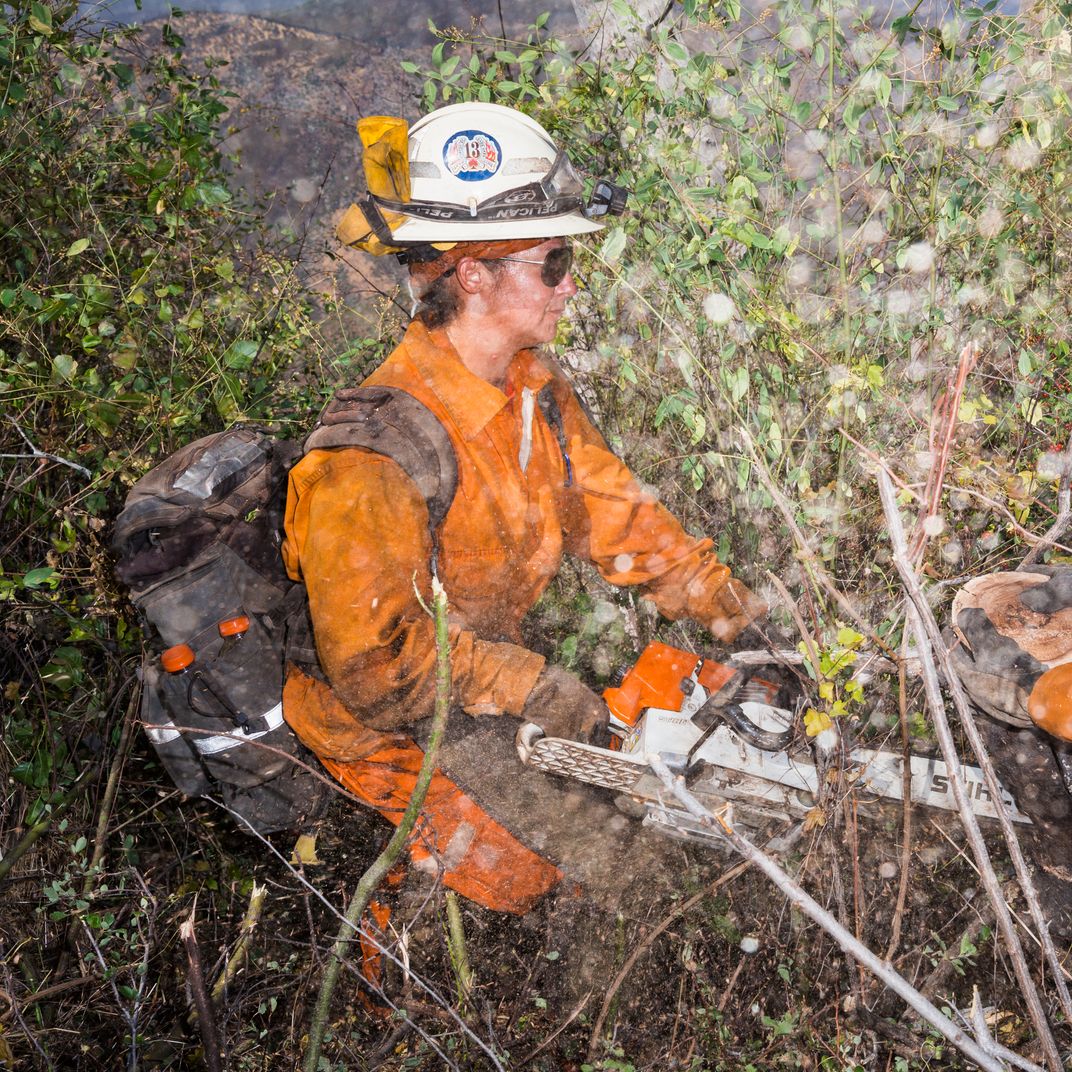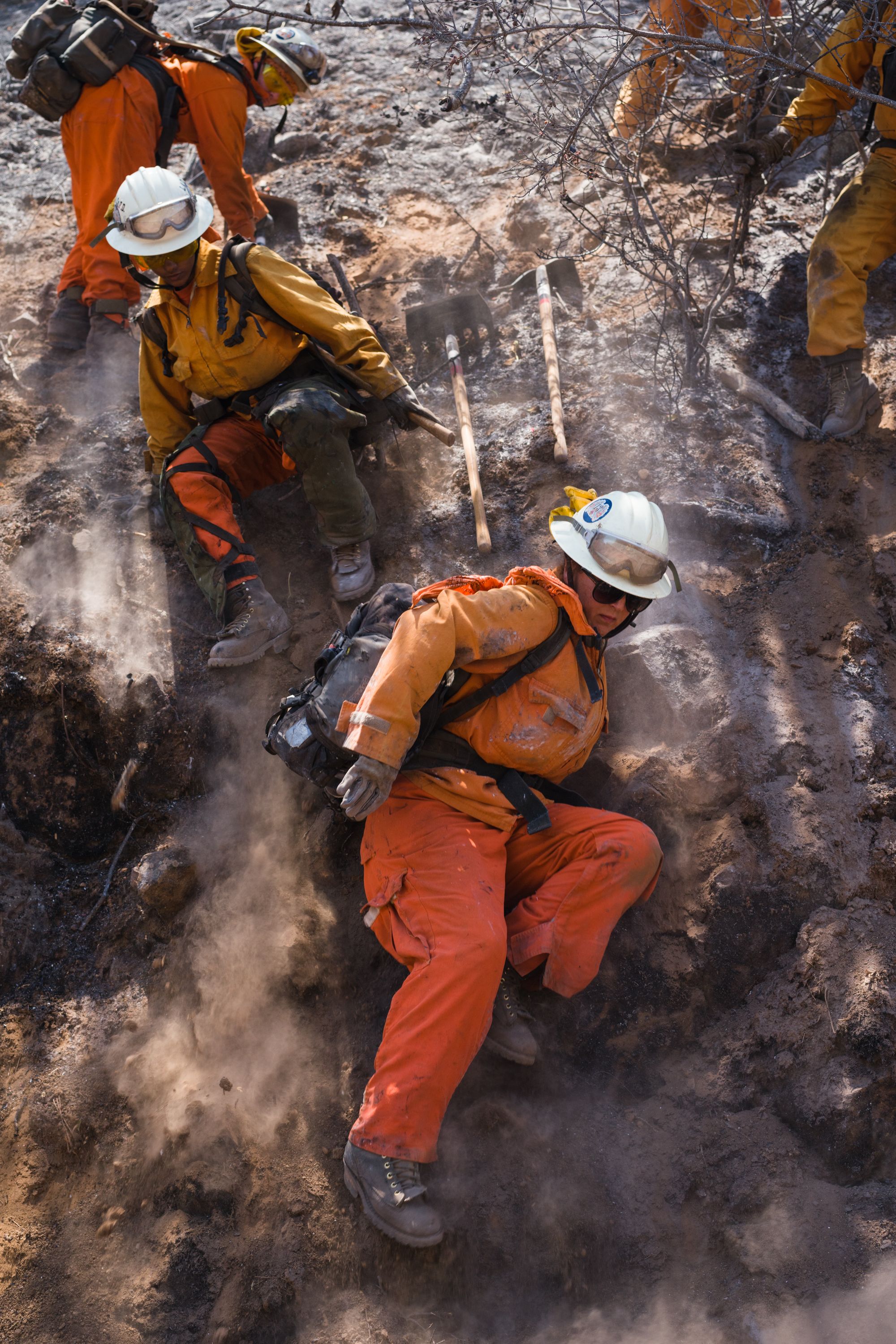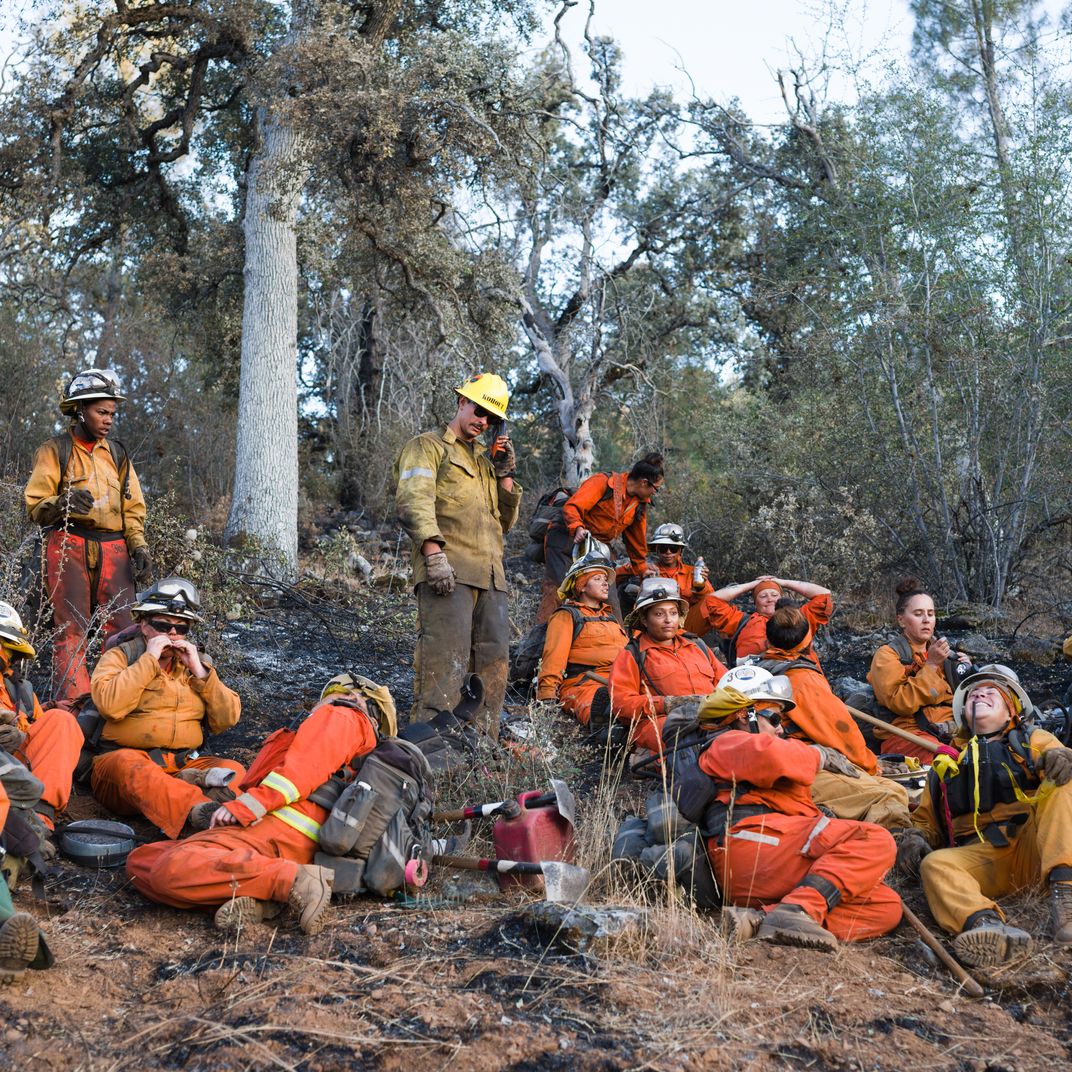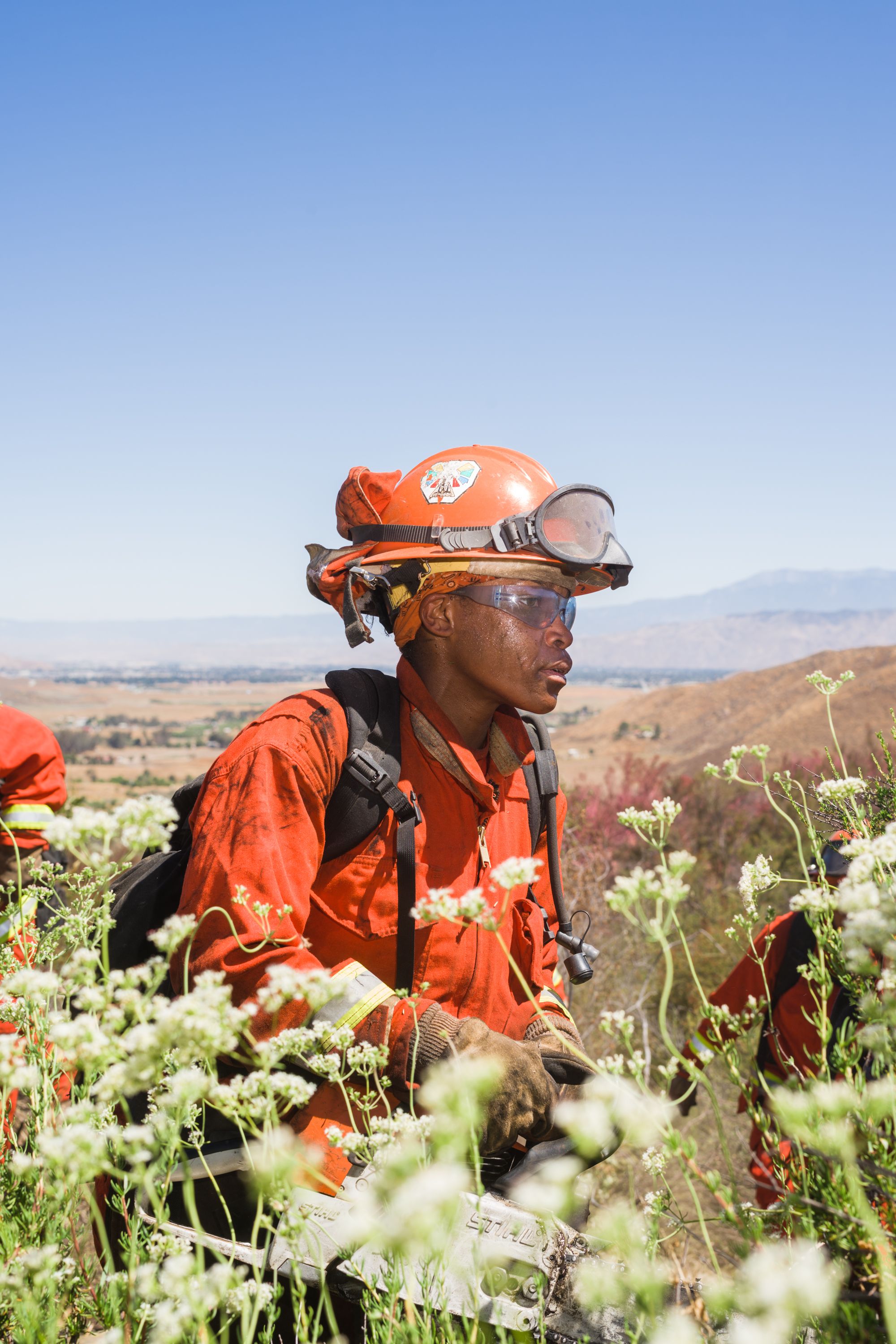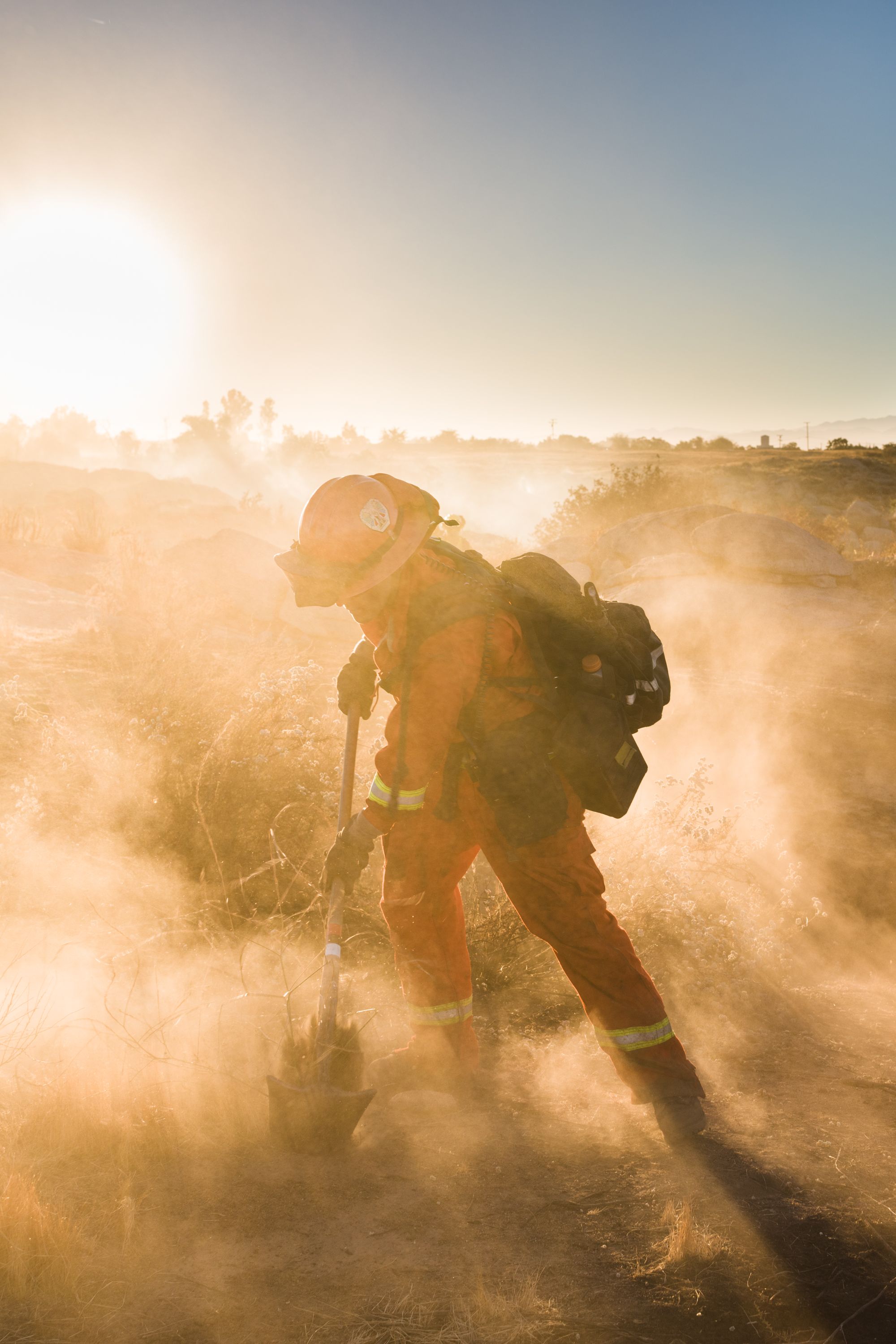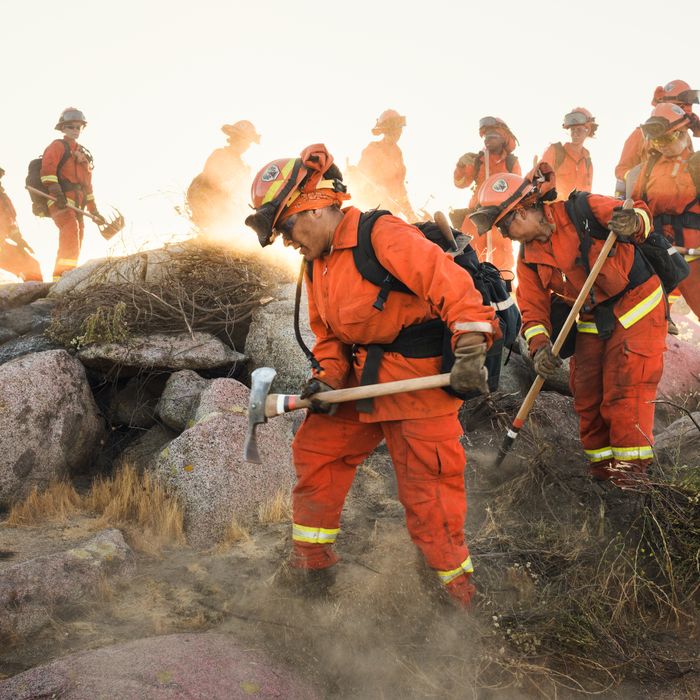
This article was featured in One Great Story, New York’s reading recommendation newsletter. Sign up here to get it nightly.
In 2017, on my way to meet female prison inmates who had been recruited to fight wildfires in California, I drove through Temecula, a region adjacent to the Palomar mountain range that has been dubbed the “Napa of Southern California.” The mountains, like most parts of the state, are prone to earthquakes. They’re relatively young, punctuated by jagged rocks jutting out and up at odd angles. The south side of the 6,000-foot-high peaks was blanketed in purple sand verbena, white dune evening primroses, and orange poppies. In some years, drought years, the mountain flowers are sparse. But when heavy rains drench the area, as they did the year I visited, thick patches of orange and magenta and purple blossoms emerge adjacent to lime green grasses. The colors blurred into a quilt of neon petals. The superbloom. At the time, it was the pride of California, and Instagram. But heavy rains and growth worried fire experts. When the last drought ended with heavy rains, in 2010, the following fire season was even more extreme than the previous one. Rain caused more grass to grow in places it ordinarily didn’t, and when summer temperatures topped 100 degrees, as they routinely do in Temecula, that grass dried out and became kindling.
At Port, about an hour southeast from Temecula, I met the camp commander Keith Radey, who was very clear about the nature of the work inmates do: “They’re doing the basic firefighting, the grunt work. They hike into the fire, and then they cut a line around that fire to try to get it under control. They’ll make a control line and then, once the fire is basically under control, they can work from that perimeter to go in and extinguish it. Yeah, you got planes that do drops and you got helicopters that do drops and all that, you might even see engines out on fire too” — those are manned by professional firefighters, he explained. “But basically, the hand crews are the ones in the trenches, and they’re mostly made up of inmate crews.”
He said the only reason female camps were established in the 1980s was that the California Department of Corrections and Rehabilitation (CDCR) was forced to offer the same opportunities to female inmates that they did to males. They deserved a shot at doing time in a place with better food and no fences and the chance to earn two-for-one credits to shorten sentences. He showed me the grounds. Radey explained that the space had been used in 2013 as a command center for a fire that ultimately consumed 50,000 acres. “They set up a full-on base camp right over here in this field. They had helitack operations, their own communications trailer with a satellite. We had a thousand people out here managing this fire.” The inmates at Port fed the free-world crews and captains, and were dispatched alongside them.
The field Radey pointed out was made up of short green grass. Technically, the state had been in a drought for six years. “As this grass dries out, that’s what they call flash fuels. They actually will spread fire to the larger vegetation such as trees and what have you. So, grass fires are actually probably the most dangerous fires, because the fire will move so quickly.” He echoed what I’d been hearing from fire experts for years — the heavy rains of 2016–2017 would make the following fire season catastrophic. While the drought might’ve been a typical drought, in all likelihood, it was an extreme weather event intensified by climate change. This long period of no rain, with a short winter of intense rain, could, in fact, be part of a megadrought. The last time the West experienced sustained arid conditions over multiple decades was a 28-year dry spell that ended in the year 1603. The difference with this megadrought is that researchers believe it’s caused by humans. Global warming has driven temperatures in the west up by 2.2 degrees Fahrenheit, increasing the risk for wildfires.
Radey also pointed to a small terror that makes every fire expert and captain shudder: the bark beetle. Smaller than a grain of rice, nearly invisible, this invasive species, originally from Central America, has been moving north as the weather warms each year. The bark beetles attack trees until nothing is left but carcasses, which become more fuel for fire to spread faster and burn hotter. “It’s like these last few years of drought combined with all these dead trees from bark beetles, and all that makes for a bad fire season. So, I’m thinking we’re going to be busy this year.” He described the responsibilities of the crews during fire season — they respond to small local calls or any out-of-counties from the Mexican border all the way to California’s border with Oregon.
During fires, Port crews provide food services from mobile kitchen units sent to base camp operations throughout the state. “They’ll feed them like, rib-eye steaks, baked potato, vegetable, with a roll. They have a full-on salad bar. We have a beverage station, any kind of drink they want. Coffee, tea, milk, soda, juices, water — if you’ve ever been on a film production, like a movie set, it’s real similar to that. These inmates eat as well as anyone working this fire — it’s very physically demanding. These meals are like 4,000–5,000 calorie meals. Cause they’re going to burn it off, you know? It’s easy to spend anywhere from $60,000 to $100,000 a day just on food. And if it’s not up to speed, the chiefs that are managing the fire, they’ll address it.”
Inmates from Port installed ziplines for the San Diego Zoo and cleared brush for the tiger attraction, cleaned water reservoirs, did brush abatement in state parks, maintained hiking trails. “The training they get here from CAL FIRE” — aka the California Department of Forestry and Fire Protection — “if you were a civilian on the street, you’d be paying a chunk of change to get this kind of training. That’s what makes these inmates so valuable when they parole, they’ve already got all the basic training.” At the time we were talking, the state effectively wouldn’t employ parolees or ex-felons. In his seven years at camp, Radey said, about 75 to 100 women had expressed interest in working in fire after release. But they’d have to retake courses and wait until they were off parole — sometimes up to ten years. The camp provided more than just training for fire, he said. “Some of these girls, especially the young ones, they don’t have a work ethic, most of them never even had a job, never had any job skills, so this is all new to them. They’ll tell us, ‘Hey, you know what, this program is the best thing that ever happened to me. It got my life turned around.’ So even if they’re not following through with the fire service, we’re actually building up their self-confidence and their self-esteem to be able to, you know, once they parole and hit the streets, they’ll be able to get a job in whatever field they choose to go to and they understand work ethic now, they understand what it is to be productive, they understand what it is to get rewarded for your labor.”
Radey walked me back to the CAL FIRE side of camp, to the saw shed where sawyers work on their chain saws — sharpening the blade, switching out the blade, doing basic maintenance to make sure equipment is ready for the next fire call. The press officer from CDCR said that they asked all the women in camp if they wanted to speak with me, but it seemed more like CDCR had hand-selected representatives of the program who excelled. The women were open but hesitant, as if they were self-censoring. They couldn’t talk to me freely, because a correctional officer was always present. I was a visitor looking in, and the crews were paraded around.
Radey introduced me to Alisha, a swamper, the highest position on crew. On fires and during work hours, the swamper communicates between the captain and foremen and the women on her crew, and leads them into battle. Sometimes, as they’re dispatched, she sits in the front seat of the fire buggy. We stood in the saw shed, where she was cleaning and arranging tools. She had long brown hair and was about five-foot-four; she was stronger than I’ve ever been in my life, or ever will be. She seemed cautious. Her crew had just gotten back from an hour-long hike near Bautista Canyon that included two pushes in elevation. The day before, her crew had been called out to the Palomar Divide to help contain a controlled burn that the Forest Service had started. “They lost it,” she said. “But it was only three acres — by the time we got up there, there were no flames.” She seemed disappointed. “We just put in a line to make sure that the fire didn’t jump again.”
Alisha told me about her crime — she was arrested and charged with residential burglary. She was 23, on meth, and had been addicted to meth since she was 15 or 16. “I come from a good family,” she said, apologetically. “I’m the black sheep of my family.” Her dad was a retired cop, and her mom worked in medical coding. As a kid, family vacations were spent in Sequoia National Forest. “I just kind of rebelled.” She told me about how the forestry program changed her life and attitude. How the work helped her focus on planning for the future: “I’ve already been doing S-190 classes” — introduction to wildland behavior — “I’ll take any classes they offer here, and I’m working on my résumé so when I do leave, I have a plan. A set plan, and I’m not just going out thinking, ‘What am I doing?’ I really want to try for the Forest Service and get a job on an engine.”
She knew that she couldn’t apply for a job through CAL FIRE or municipal agencies, because they require EMT licenses, which you couldn’t get if you were an ex-felon or on parole. She wanted a plan for her daughter. “Everybody can carry what we learn here to the street. Just the responsibility, and being able to multitask. Everything that we do here, even if you’re not going to actually do this when you get out, you can carry this on to the rest of your life.”
After Alisha’s arrest, her parents became legal guardians of her daughter, Kayleigh. They lived in Long Beach and would visit Alisha at Port once a month or once every two months. When Alisha was in state prisons, in Chowchilla and CIW, she wouldn’t let her parents bring Kayleigh for visits — it was too grim. Alisha couldn’t stand the idea of her daughter seeing her in those places. At Port, she could bring out the rainsticks made from yucca or plaques painted in hobby craft and give them to Kayleigh. Alisha’s dad would pick up Mexican food from Aztek Tacos on his way. They’d eat at the picnic benches. Alisha could show Kayleigh the birds and the mountains that she protected. They’d walk the grounds of Port looking for peacocks and wild turkeys.
Alisha told me about her first fire, going into Napa Valley as residents were evacuating. The town was burned over; cars were blackened. She wondered why they, as a crew, were racing in as residents were racing out to save themselves. She understood it intellectually, this was the job she signed up for, but practically, she could feel the heat, the terror coursing through a community. She cut line for ten hours, almost until dawn. The first few hours she was hotlining, cutting roots and trees and stumps as they burned. She told me the heavy labor and the danger create a bond among the crew members, that you have no choice but to work together.
Raven Vasquez, a sawyer from Malibu Camp 13, cutting line on the Detwiler Fire in Mariposa County, CA.
Firefighters from Malibu Camp 13 descend a steep slope on the Detwiler Fire in Mariposa County, CA.
Crews from Malibu Camp 13 take a break while fighting the Detwiler Fire in Mariposa County, CA.
Many of the women in the crews express interest in continuing firefighting work after their release from prison.
Raven Vasquez, a sawyer from Malibu Camp 13, cutting line on the Detwiler Fire in Mariposa County, CA.
Firefighters from Malibu Camp 13 descend a steep slope on the Detwiler Fire in Mariposa County, CA.
Crews from Malibu Camp 13 take a break while fighting the Detwiler Fire in Mariposa County, CA.
Many of the women in the crews express interest in continuing firefighting work after their release from prison.
She also talked about more practical things, skills beyond fighting fire that she learned, like truck maintenance, roofing, operating a chain saw, working a weed whip. “I’ve dropped trees,” she said casually. She has also poured concrete, changed oil, done demolition, and painted structures. The crews were always at work. And when she wasn’t at work, Alisha worked out or read or was just so exhausted, she passed out. “Everything happens for a reason, and I really feel that this is what I needed,” she said. “Now I can be a mother to my child, and be there. I’m ready to go home to her. It kills me that I’ve been away from her for so long, because I got locked up right before her 2nd birthday, so I was only out for her first birthday, and she’s turning 6 this year.”
Before I left, Radey showed me a few other parts of camp — the cosmetology department, where haircuts, makeup, and blowouts happened. This was where cosmetologists who also happened to be firefighters trained and received licenses. He took me and my correctional officer minder toward the dining hall, where the inmate kitchen staff was preparing for dinner. There was a morning cook and an evening cook, and each cook had prep staff; inmates cleaned up, some were dishwashers and scullery workers. About seven women worked the dining room. He showed me the industrial- size mixer, the size of a small human, used for baking cookies, cakes, pies, cinnamon rolls, pizza dough, bread. There was a deep fryer, a burger grill, a prep station for chopping. The food was clearly better, but crews were served in the same manner as in prison — every inmate lined up in front of steamers to receive four ounces of meat, a scoop of starch, a scoop of vegetable. Exactly the same plate, same quantity.
Radey asked the afternoon cook what she was making and if she could serve us a plate. We sat around a stainless-steel table on stainless-steel seats where crews would ordinarily be eating in hookline order. I was served several pork chops and steamed vegetables, which the correctional officers dug into. The chef was proud of her work — and it tasted good — but I felt guilty. I was eating inmate labor.
The next camp I visited is located just south of Temecula. Rainbow is spread out. It houses 100 at full capacity. On my tour of the grounds, I saw a dirt softball field and busted speed bag for boxing. Rainbow also had a cabin that could be rented out for overnight visits. Again, the correctional officers asked if anyone would be willing to sit with me and talk, and about a dozen women offered.
Marquet was the first woman who entered the room. She was so shy, she seemed to be hoping that the correctional officer monitoring our interview would help her share her story. She’d look over to her for approval, guidance, a way to navigate talking to me. She spoke softly but confidently. “I came here because I wanted to better myself. I’ve never really accomplished anything. I always had jobs, but I only had them for a week. So, I came here and decided that I needed something to work on me. It helps me with people — how to deal with people, how to handle situations.” Marquet arrived at Rainbow with her 10s and 18s — rules developed in 1957 to prevent fatalities and injuries — already memorized and a kind of authority and assuredness. She described a life prior to prison riddled with abuse, drug use, and homelessness. When she talked of fire, she took on the command of a captain. Her eyes widened and she recited details of procedure and proper conduct. Here, at Rainbow, she was a firefighter.
“You always have to be aware of where your fire is, because if that fire comes back at you, it either can kill you, or you can survive — regardless, you have to know. You need to know where your escape route and your safety zone is, and if you can actually get to that safety zone where you can deploy your shelter. If you can’t deploy your shelter and your fire is coming toward you, there’s a possibility you could die.” She rattled off all the scenarios in which she would need her 10s and 18s: “While you’re fighting that fire and cutting that line you need to have it in the back of your mind, ‘Look up. Look around. Keep your ears open. Communicate.’” Lessons she had already learned at Chowchilla and CIW — watch your surroundings, communicate — but applied in different ways.
She gave me a supercut of what she went through to get to this point. Counting all of her half siblings and stepsiblings, she was one of 14 children, and the fifth youngest. When Marquet was 2, her mother was sentenced to Chowchilla and then CIW; her father was in and out of jail. Marquet was from Southeast San Diego — her whole family was there. If Marquet could have chosen where to live, it would have been with her aunt Sue and her sisters and brothers from her mom’s side of the family. Instead, her 38-year-old sister, Olivia, on her dad’s side, took her in. Olivia became her foster mom, and her husband, Robert, signed on as her foster dad. Caregivers receive roughly $800 a month from San Diego County to cover food, clothing, and rent for taking in foster children. California has the largest number of children entering the system each year. Black kids are historically and currently overrepresented in foster care, making up 23 percent of foster children while being only 13 percent of the population. There are endless studies about the foster-care- and group-home-to-prison pipeline. But, for Marquet, there weren’t a lot of options.
With Olivia, the facade of home existed, but Marquet never felt folded into a family. If Marquet misbehaved, she was left at home in her bedroom by herself with no food. Much of the time, she was tasked with taking care of her sister’s youngest son, Joseph, a baby with physical disabilities who eventually needed a wheelchair for mobility. Marquet resented him, and she resented Olivia for saddling her with adult responsibilities. Marquet also didn’t get along with her brothers, her nephews, or anyone in the house she lived in. So she avoided the house.
By the time she was ten, Marquet was sneaking out of her sister’s house regularly, running away to her aunt Sue’s place. She’d hop the trolley, then the bus, and then walk three miles uphill. Once there, she would try to be as quiet as possible. She didn’t want her aunt to call her sister, triggering her return. She’d sneak in the window and plead with her cousins, “Let me stay here. All I want to do is live here.” There, she had warmth, the siblings she liked and got along with, the ones who felt more like kin. After every escape, though, Olivia would show up at Sue’s to collect Marquet.
One afternoon, Marquet got out of school early and asked Olivia if she could go to the mall with a friend. The answer was no. Olivia wanted to go out and she needed Marquet to watch Joseph again. Instead, Marquet ran. She met up with her boyfriend at the time, they wandered the mall, then the park. There, she noticed a figure moving toward them.
It was Robert, her foster dad. He started chasing Marquet. She booked it in the opposite direction, but he ran faster. He snatched her, grabbing her hair and dragging her to the gate. Her scalp tightened in pain. Her skin scraped against the concrete of the park. It ripped open, droplets of blood staining the ground. She had a lighter in her pocket.
“Let me go before I burn you,” she said.
He grabbed the lighter and set her hair on fire. She felt the heat travel toward her face. The sight of flames and the smell of singed hair propelled Marquet to fight back, to hit and kick and scream until several bystanders ran over and intervened. One helped Marquet put out the flames, another called the cops. Robert was arrested, and ended up in County for one month. Whatever stake Olivia had as Marquet’s foster mom vanished. She wasn’t willing to sacrifice her marriage for a sister who barely counted as a sister.
After that, Marquet unraveled. She had nowhere to go. Her aunt Sue couldn’t take her in. Between the ages of 14 and 16, she was placed in multiple foster homes and group homes. She lived in Hillcrest House and was kicked out; then Oceanside for two months before being kicked out (“I don’t even remember why, I think I was just being bad”); she went back to living in Hillcrest; went to a group home in Mira Mesa and was kicked out; went to juvenile hall, programmed out; then finally she lived in Woodman, another group home. During this time, she was enrolled in El Camino High School, but because of repeated fights with other students and truancy, she was kicked out.
Then, at 18, Marquet aged out of the foster care system.
Marquet gave birth to her first son, Bernard, in 2009. Just 26 hours later, Bernard’s dad “left with his other baby mama and never came back.” Marquet moved on to her next relationship, with Joe. “That’s when I started doing drugs,” she said. The first time Joe hit Marquet was when she told him she was pregnant with her second child. He didn’t even want Bernard around. “He wasn’t physically abusive to Bernard, like he didn’t hit him or nothing, but he would do or say stuff to him. He tied Bernard to a dog once and made the dog run. I asked him why he did that,” Marquet said. “And Joe just started laughing.” Marquet had the baby and named him Unique.
When Marquet did meth she felt adrenaline and power and like her life was straight. She felt smarter and focused and more diligent. She felt like a better mom, a better person, someone whom other people wanted to be around. She felt welcome and whole.
Marquet walked down the block. She didn’t know the street. She didn’t know the time. She broke into a stranger’s house. She described the night to me: “I was just under the influence on meth and felt like doing something. When you’re under that drug, you really just go with the flow. You feel like you’re invincible. Can’t no one stop you — you’re just the king or the queen of the world. I got under the influence and started walking down the street, saw a house with the window open and decided to go in. Through the window.”
The woman inside the house called 911. With two strikes already, Marquet knew she would be sentenced to a mandatory minimum sentence if she was caught. So, she ran. The police took down a description of Marquet — young, maybe early 20s, Black woman with a slight gap in her teeth. Enough information, when processed through the system, for police to narrow their search. Just a day after Marquet’s living room visit, she applied to work in Urban Corps, a paid job that offered training, support services, and a second chance for Marquet to earn a high school diploma. Part of the application process included submitting a California state driver’s license and a Social Security card. She was chopping trees down as part of her landscaping program, working to beautify the city, when the police arrested her. She was charged with first-degree burglary and taken to San Diego County jail — just one of the thousands of women ensnared in California’s harsh three-strikes laws.
At Rainbow, Marquet didn’t have visitors. Her kids, Bernard and Unique, were under the care of her younger sister, who worked and couldn’t make the drive up from San Diego. Marquet went to prayer meetings after dinner every Sunday, Monday, Tuesday, and Thursday. She worked on her drug addiction by attending Narcotics Anonymous and Alcoholics Anonymous meetings. But it was the firefighting that really freed her. “On fires it was just me and the fire, I was alive, I was accomplishing something,” she said. “It takes all your fear away, it was an escape route. It became my new drug. Everybody is addicted to something, it’s in our human nature. It’s just what you do with that addiction.”
Marquet Jones, a sawyer with Rainbow crew 4, cutting line on a small fire near Hemet.
Marquet, who had previously been addicted to meth, said fighting fires “became my new drug.”
A firefighter from Rainbow Camp cutting line on a small fire near Hemet.
One inmate said, “Everything that we do here, even if you’re not going to actually do this when you get out, you can carry this on to the rest of your life.”
Marquet Jones, a sawyer with Rainbow crew 4, cutting line on a small fire near Hemet.
Marquet, who had previously been addicted to meth, said fighting fires “became my new drug.”
A firefighter from Rainbow Camp cutting line on a small fire near Hemet.
One inmate said, “Everything that we do here, even if you’re not going to actually do this when you get out, you can carry this on to the rest of your life.”
On her first fire, the Pala Fire, Marquet was nervous. She knew she’d start like everyone else, at the back of the line. She hoisted her McLeod, a tool best described as a kind of fire rake, and piled into the buggy first, ready to exit last. She’d carried a McLeod at CIW, and used it to clear brush, but never in live fire. She cleaned up behind the dozen crew members ahead of her, tugging and scraping the roots from the soil to prevent further burns. Her captain explained that the Pala Fire had started at one residence earlier in the week and spread through 45 acres before it was contained by CAL FIRE and San Diego County Fire. But containment does not mean the fire is controlled, particularly when it occurs during a heat wave and high winds. When they arrived, embers were being blown off still-smoldering brush and hot spots began skipping through the landscape. The Pala Fire wasn’t out, and now its flames threatened 70–100 structures. Homeowners on the east side of Pala Temecula Road evacuated to a high school in Temecula. Marquet’s crew and Alisha’s crew, among other crews, were there to protect those homes and the vineyards that supplied grapes for the wineries of Temecula.
Marquet had never felt anything like fire before. She wanted to run. “It’s hot, you have all this gear on. And you have to hike through. Just when you feel like you can’t go no more you keep going. It helps you to work as a sister crew, cause you have other people on your crew and you learn how to work with them, you know — cause, really all you have is each other on that, when you’re on a fire. If someone goes over that cliff, you have to help that person get off that cliff. If someone passes out you have to bring them down the cliff.” This was the kind of camaraderie and responsibility that Marquet had never trusted or been entrusted with.
“Your feet are hot and tired and they have a pulse of their own. You feel like you can’t breathe, but you’re breathing. Your face feels like it’s about to melt off, but it’s there. It’s just — you have to be aware of everything. You have to be — you have to be able to listen. If you cannot take instructions from either your swamper or your dragspoon or your captain, you’re not going to survive. You have to be able to receive it and to be able to get it.” Receiving instruction had never been Marquet’s strength. But now, her life depended on it. “You have to be humble, you have to be patient, you have to be open ears,” she said. Most of what we talked about at Rainbow fell into two categories: detailed descriptions of fire or her feelings of faith. They both seemed to be religious experiences.
She could see that what she was doing helped. On a fire in Nevada County, kids held signs that said, “Thank you for saving my house, thank you for saving my dog.” Most women I interviewed recalled signs of thanks. People wrote cards. Brought out snacks and cake. It felt good to save someone’s house. “Some people, they look down on us because we’re inmates, you know, and sometimes you want to say, ‘Well, I’m the one that saved your house!’” Marquet said. “But there’s a lot, a lot, a lot of people that actually are thankful and are happy — even little kids that got tears in their eyes.”
In Marquet’s first winter at camp, just months before I met her, California was inundated with rain and snow, generated by the El Niño weather system. Between October and January, downtown Los Angeles had recorded more than 13 inches of rain — 216 percent more than the norm. Since official record keeping began, more than 140 years ago, the past five years had been the driest ever in downtown L.A. Now, the state was drenched.
Five years of dry heat and parched land had shifted into a season in which the Sierra mountaintops were white with snowpack. Hundreds of thousands of acres had gone unplanted; Central Valley water tables plunged. With the rains, farmers in the Central Valley celebrated what seemed to be the end of the drought. They could count on more than drinking water; they could plant again and cultivate trees.
But extreme rains and El Niño winters can be as destructive as fire seasons. And inmate crews are responsible for responding to catastrophic flooding in addition to fire. The years of loose, parched soil created perfect conditions for mudslides and unhealthy riverbanks. Roots that held earth in place had been so dry, and ravaged by previous fire seasons and the infestation of bark beetles, that heavy rains, despite providing welcome relief from drought, were not welcomed by all.
In late January 2017, a storm dumped nearly eight inches of rain over the course of four days in the San Diego area. Thunder shook the mountains and valleys and beaches. Cars were submerged; trees uprooted. The beaches were under high wind warnings and waves peaked at 16 feet, bringing strong rip currents and coastal flooding. As flash floods hit the inland communities nearby, then-Governor Jerry Brown issued a state of emergency for San Diego. While people hunkered down in their homes, inmates were put to work as first responders. Rainbow camp crews assembled sandbags and hauled them to low-lying, vulnerable neighborhoods.
Marquet’s crew dispatched to a different assignment. During the rain’s waning hours, they drove to the Rainbow River. The town of Rainbow had known fire — in October 2007, the Rice Fire was one of the 30 wildfires fueled by Santa Ana winds that burned almost 1 million acres, from Santa Barbara County to the U.S.-Mexico border. In Rainbow and neighboring Fallbrook, almost ten thousand acres burned, leaving 248 structures destroyed. Crews from Rainbow and Port helped then. And now, ten years later, when the town was drowning, inmate crews returned.
Marquet wasn’t told much — just to follow Search and Rescue Swift Water teams and stick close behind them. She could see the men wade through the raging river, still swollen and higher than the community had ever seen it before. She could see them hack away at fallen trees and debris blocking forward progress. She could hear the cadaver dogs barking. Everyone who was out, including the sheriff’s crew, was looking for a 5-year-old boy and a 73-year-old man, whose car had careened off the road and into the river. Marquet tried to focus on what their assignment was — follow Search and Rescue. Be a second set of eyes. Hack away at all the growth that had fallen in the heavy rains.
By the time Marquet was out at Rainbow River, old man’s body had been found. But the sheriff’s department, Search and Rescue, cadaver dogs, and now CAL FIRE inmate crews were all looking for the boy, hoping he might still be alive. The river was 80 feet wide and 16 to 18 feet deep. Marquet and her sawyer marched in the shallows behind Search and Rescue, continuing to hack away as they tried to uncover areas they might not have seen. “I was praying he was still alive,” she said. “I was really praying he was still alive.”
At one point, when the Search and Rescue crew moved ahead, Marquet’s captain told them to stay behind, to work that part of the riverbank a little bit longer. Marquet had been in camp for nine months. She was training to be a saw — the person who leads her crew into brush with a chain saw — and her captain said it would be a good time to practice, a good place to get in some cuts. He showed her one spot to work. She cut, and the rest of the crew cleaned out the area. They moved to another area, same thing. Marquet cut through the debris while her bucker cleaned out the wood and cleared the soil. The captain watched, then motioned for Marquet to move on to another spot. As her bucker was clearing the debris, Marquet saw the body. The little boy was partially buried under six feet of leaves and dirt and muck. “I believe that God played a part in that, you know — from me not cutting and my cap telling me to stop and move over there — cause it would have hurt me even more to find out that I had cut a body up,” she said.
The inmate crews were rushed back to the bus while the captains finished the body removal. The CAL FIRE division chief Nick Schuler called it “a needle in a haystack to find this boy.” Marquet sat in the buggy, shaken. “Our minds were crazy with just that little piece.” He was the same age as Marquet’s eldest son.
This is an adapted excerpt from Breathing Fire: Female Inmate Firefighters on the Front Lines of California’s Wildfires, by Jaime Lowe (MCD/Farrar, Strauss & Giroux; July 27, 2021).


